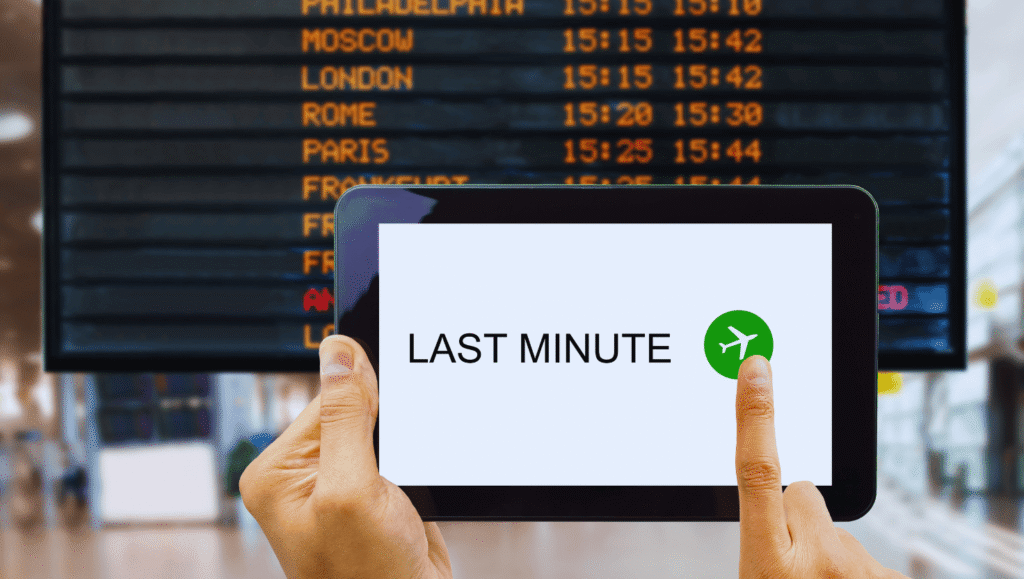
I. The Myth vs. The Math: Understanding the Last-Minute Trap
A. The romantic illusion of spontaneous travel
There is a powerful, romantic narrative surrounding spontaneous travel: the idea that by waiting until the very last moment, the doors to dramatic savings automatically swing open. However, this common assumption overlooks the deep economic reality of the airline industry. The traveler hunting for a cheap, last-minute ticket believes they are competing against other travelers for empty seats. The strategic truth, however, is that the traveler is actually facing a relentlessly precise and sophisticated algorithm—the Yield Management (YM) system—which is designed to set the price perfectly against their willingness to pay.
B. Why airlines don’t want you to wait (and why the price is usually high)
Contrary to popular travel folklore, airlines actively avoid teaching passengers that it pays to delay buying a ticket. Such behavior would lead to the collapse of their entire revenue management model. Therefore, the strategic starting point must be the understanding that the standard pricing for late bookings, in the final days before departure, is a
premium price.
Airlines employ rigorous YM systems aimed at maximizing revenue, not necessarily achieving 100% load capacity. A key component of this system is the practice of limiting the number of discounted airfares to reserve (protect) seats for higher-revenue customers on the same flight. These customers, often business travelers, book at the last minute and are willing to pay the full price due to necessary flexibility.
Protecting seats means that empty seats at the last minute rarely represent unsold, cheap inventory. Instead, they are protected seats, reserved for the high-value passenger segment. The strategic traveler must therefore shift focus: instead of randomly searching for a cheap seat, the goal becomes identifying specific flights where the airline, due to a failed demand forecast, is forced to abandon its premium strategy and proceed to liquidate capacity.

II. Decoding the System: How Airline Algorithms Control the Prices
A. Yield Management (YM): The blueprint of your ticket price
Yield Management (YM) represents the fundamental capacity management strategy in the airline industry. This approach was pioneered precisely in the airline sector before spreading to the hotel and other service industries. The power of this system is undeniable. Airlines that adopted YM systems saw a direct revenue increase of 3% to 7%, and in some cases, a profit increase of 50% to 100%. Specifically, American Airlines and Delta credited YM policies for annual revenue increases of $500 million and $300 million, respectively.
These figures emphasize that the YM system is extremely efficient, and its goal, as defined by Wang and Bowie, is to maximize revenue through the effective management of three key domains: pricing strategy, control of availability, and inventory control.
B. The three pillars of pricing: Price, availability, and inventory
The functioning of the YM system is focused on dynamically balancing supply and demand. For the traveler, understanding the role of each of the three pillars is crucial for anticipating when and why price changes occur:
- Pricing Strategy: Determines the fare classes (e.g., discount and full price).
- Control of Availability: Refers to managing the total number of seats offered in each fare class, known as “fare buckets.”
- Inventory Control: Relates to managing physical resources, such as the aircraft type, crew availability, and fuel. Ultimately, Inventory Control sets the fixed limit on the number of seats (e.g., 156 seats on an Airbus A320).
The most critical dynamic for the last-minute traveler lies in the interaction between Pricing Strategy and Control of Availability. Pricing Strategy sets the expectation of high value for late bookings. However, Control of Availability, which dynamically monitors reservations , dictates how many seats from the premium class (held empty and protected) must finally be released for sale at a discounted rate to generate marginal revenue and cover the flight’s operational costs—this happens when the original Pricing Strategy fails to attract the expected clients. This moment of release is the opportunity the strategic traveler seeks.
| Pillar | Definition and Goal | Last-Minute Implication for the Traveler |
| Pricing Strategy | Determining the optimal price for different market segments (discount vs. full price). | Deals only emerge if initial strategies fail to attract expected premium buyers. |
| Control of Availability | Managing the total number of seats offered in each price class (‘buckets’). | Target flights where protected, high-value “buckets” are unexpectedly released due to weak demand. |
| Inventory Control | Managing physical resources (aircraft, crew, fuel) and maximizing their utilization. | Final deals can appear due to operational constraints (e.g., flight consolidation) requiring urgent capacity liquidation. |

III. The Seat Protection Game: When the Airline Holds Back
A. The high-roller holdout: Why business travelers rule the clock
The core of the airline’s last-minute strategy is capacity protection. Airlines typically define at least two fare classes, or “buckets”: discount tickets (for leisure travelers, with strict restrictions and requiring early booking) and full-fare tickets (for business travelers, flexible and available for late booking). Revenue managers intentionally protect a certain number of seats from being sold at a discounted rate, knowing that passengers willing to pay the higher price will buy their tickets later.
This strategy works thanks to “fences” or “barriers” that differentiate the market segments. It is important for the traveler to know that business trips are often decided only a week or two before the travel date. It is this short demand window that dictates the airline’s pricing strategy during the final 7 to 14 days of the flight: prices must be kept high to successfully “capture” this high-value, inelastic demand. The discount traveler only enters the equation after it is determined that the expected business traveler will not book.
B. The ticking clock: From long-term forecasts to short-term liquidation
Capacity management decisions are divided into long-term, medium-term, and short-term planning. Last-minute opportunities for travelers occur exclusively within the short-term horizon, when forecasts must be replaced by real load factors.
An important characteristic of the YM system is that, while it generates higher overall revenues, the revenue streams often arrive later in the booking horizon because capacity is held for late sale at premium prices. This tendency to wait for the highest possible price explains why prices naturally rise as the flight date approaches. Therefore, any genuine last-minute price reductions represent an economic pivot—an admission by the airline that its highest-revenue forecast for that specific flight failed, and the priority is now cost recovery by liquidating the remaining protected inventory.
| Time Window (Days Before Departure) | Airline Strategy (YM Focus) | Strategic Actionable Insight |
| 90+ Days | Maximizing the sale of discount seats for early cash flow; low flexibility. | Aim for the deepest discounts; greater transparency. |
| 30-7 Days | Discount retraction phase; increased capacity protection for business travelers. | The “danger zone” for leisure buyers; prices are dictated by high-demand forecasts. |
| 7-0 Days (Last Minute) | Maximizing revenue through full prices; active capacity protection. | High risk/high reward. Look for signs of low load factors or unforeseen capacity surplus. |

IV. The Holy Grail: Anatomy of a True Last-Minute Steal
A. The algorithm’s weak spot: When demand forecasting fails
A true last-minute steal is not the result of marketing generosity, but a direct consequence of a failure in the airline’s algorithmic demand forecasting, particularly in the premium fare segment. YM systems are equipped to monitor reservation activity and enable accurate demand forecasting, which in turn allows them to dynamically adjust discount allocation and fare availability.
However, no model is perfect. When the prediction of high business travel demand in the final days fails, the system is faced with a surplus of protected seats. Since physical inventory (seats) cannot be stored, the system must make a decision to sell that capacity to recover costs.
From the airline’s perspective, releasing a last-minute discount is a rare anomaly that confirms the rule of high short-term prices. Airlines actively fight against the idea that waiting pays off, as this would disrupt their revenue management model. A successful acquisition is therefore the direct exploitation of an operational weakness in the airline’s defensive mechanism.
B. The Goldilocks zone: Timing your strike (48-72 hours)
The strategic fare hunter must focus their search on routes and times that are inherently less attractive to premium, business travelers. These are the scenarios where the probability of YM forecasting failure is highest. Such scenarios include flights outside major business hubs (non-hub to non-hub), flights on unpopular days (Tuesday morning, late Saturday evening), or during periods when business activity is low (holidays).
The YM system continuously monitors reservations and adjusts availability. The critical liquidation phase occurs when the system realizes that the load factor for protected seats is irreversibly low. Since business travel decisions are often made up to a week before departure , the system requires additional time to process the data and execute adjustments.
Most often, the optimal window for deep discounts opens very close to departure, typically between 48 and 72 hours before the scheduled flight time. In this short interval, the marginal price of selling a seat (at a deep discount) becomes less than the cost of flying with an empty seat.
| Airline Signal | YM System Behavior | Traveler Interpretation and Action |
| Sudden, significant price drop 48-72h before the flight. | Failure in premium demand forecast; moment of protected seat liquidation. | Buy immediately. This is a direct release of full-fare “buckets” at a discount price. |
| Low Load Factor on less popular connections. | Capacity used as part of a wider alliance/code-share agreement that isn’t filling up. | Less competition for seats; higher chance for deals to appear. |
| Very high prices maintained until 24h before departure, followed by a slight dip. | The last desperate attempt to capture the final premium passenger, followed by a gradual “fade out” of discounts if demand does not increase. | Wait, but be prepared to buy in the final hours; do not expect a major drop. |

V. Your Insider Playbook: Becoming a Strategic Fare Hunter
A. Flexibility: Your secret weapon
Given that the airline’s physical capacity (the aircraft) is fixed , the traveler’s greatest asset is demand variability. To exploit weaknesses in the YM system, the traveler must demonstrate extreme flexibility regarding destination, date, and, most importantly, flight time. Focusing on flights that business and fixed-agenda travelers avoid (e.g., flights early on Tuesday mornings or Saturday afternoons) dramatically increases the chances of running into a demand forecasting error.
B. Beyond the direct route: The art of geographic manipulation
Airlines use market segmentation systems and “fences” not only through time of purchase but also through geography. Often, prices for connecting through secondary cities, which serve as capacity-filling points, differ from the prices of direct flights.
The strategic traveler should explore options for flying from secondary or tertiary cities that connect through the desired hub. Sometimes, attempting to buy a ticket for route A-B-C may be cheaper than buying route A-B only, because the price is determined based on the matrix for filling the total capacity, not just a single segment.
C. Track the seats, not just the price
Standard flight search engines only provide the final price, which is the final output of the YM algorithm. The true strategic traveler must seek tools and techniques that can infer the algorithm’s inputs—specifically, the state of Control of Availability and Inventory.
Experienced travelers monitor changes in specific fare classes, usually denoted by letters (e.g., Y and B for expensive, flexible tickets; L and Q for the deepest discounts). When the YM system suddenly releases a large number of seats in a low-fare class (L or Q) 48 hours before the flight, it is a reliable signal of a liquidation event, which usually precedes a price drop.
D. The decisive moment: Strike hard and fas
The YM system is designed to delay revenue intake by holding capacity for premium sales until the last possible moment. Therefore, the traveler must be patient, yet extremely decisive when the opportunity arises.
The optimal purchasing window, backed by system behavior analytics, is between 48 and 72 hours before departure, provided clear signals of low load factor are present (Table 3). This is the moment when the “wait for the best price” model breaks, and an irrevocable operational decision is made.
The traveler must accept that most last-minute searches will result in premium prices. Success in this strategic game depends on viewing the system as a highly regulated arena, where you only play when, due to a temporary forecasting failure, the strategic advantage temporarily shifts to the traveler’s side.

VI. Conclusion: The Informed Traveler Win
The quest for the ideal last-minute flight ticket transcends mere shopping; it represents an analytical endeavor and an economic strategy. Understanding that the dominant airline strategy is to preserve high short-term prices—a model that has generated hundreds of millions of dollars in extra revenue for major carriers —shatters the illusion of simply stumbling upon a discount.
A true last-minute catch is not a matter of luck, but the skillful exploitation of a critical point in a complex predictive system. The informed traveler understands the architecture of revenue management, knows the three pillars of YM (Price, Availability, and Inventory), and recognizes when the airline’s protective mechanisms break down due to overly optimistic demand forecasting.
The traveler who adopts this strategic perspective ceases to be a passive consumer reacting to prices. Instead, they become an analyst and planner, capable of predicting the short, critical window of capacity liquidation 48 to 72 hours before the flight. The triumph of the informed traveler lies in the ability to exploit a flaw in the system, not its generosity, thus transforming last-minute flying from a risky venture into a calculated strategic move.

